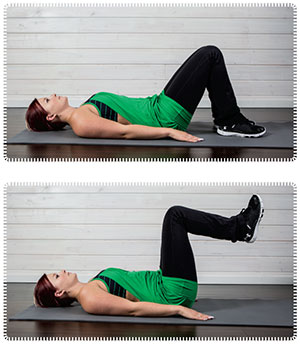
Fitness depends on a strong core. Learn which muscles make up your core and the benefits of strengthening these muscles. Then try our basic workout routine to help you achieve a strong core in 2016.
If you suffered from low back, neck, or joint pain in 2015, you might want to get to the core of the problem by setting a goal to build a stronger and more stable core for 2016. Working on your core can have wonderful benefits, including more efficient workouts and reduced risk of injury during exercise and daily tasks.
What is the core anyway?
Your core includes not only the “six-pack” muscles, more technically known as the rectus abdominis, but also the other muscles of the pelvis, lower back, hips, and abdomen.
Consider your core muscles the central link between your upper body and lower body; they act to stabilize, produce force, and protect the body during actions as intense as kicking a soccer ball or as simple as vacuuming the house. The core has to be strong and stable, but also flexible, in order to allow the body to move through all planes of motion comfortably and safely.
What’s the difference— core versus ab training?
Core training exercises target not just the abs, but also the back side of the body (posterior chain) such as the muscles of the lower back (erector spinae) and gluteal muscles. Core training exercises mimic real-life activities, forcing all the muscles of the core to work together to stabilize the body, much like real-life actions.
Core training workout
This basic core training workout can be done on your living room floor. Perform one set of each exercise before moving on to the next. Once you have completed one set of each exercise, return to the beginning and repeat for two to three rounds.
Exercises
Pelvic Tilt with single leg Raise

- Lie on your back with your knees bent, feet flat on the floor, and arms at your side, palms down.
- Draw your belly button toward your spine without holding your breath so that you feel your lower abdominal muscles engage.
- Raise one bent leg up until you have a 90-degree angle at your hip, and lower it back down. If doing it correctly, you should feel your abdominal muscles doing the work to raise your leg up and down, not the muscles in the front of your leg.
Too easy?
Make this exercise harder by raising both legs at the same time!
Quadruped

- Begin on your hands and knees, with your wrists directly underneath your shoulders and your knees directly underneath your hips at a 90-degree angle.
- Look down at the ground and draw your belly button toward your spine.
- Raise your right leg straight back while you simultaneously reach your left arm forward until they are both straight and parallel to the ground.
- Hold this position for 3 to 5 seconds, squeezing your glutes and upper back muscles, making sure your lower back does not dip.
Prone airplane

- Begin by lying on your stomach with arms perpendicular to your body and legs straight.
- Draw your belly button toward your spine, look up, and raise your legs and upper body up off the floor as high as you can while squeezing the muscles between your shoulder blades and your glutes.
- Hold for 2 to 3 seconds and return to the floor.
Plank with single Leg Raise

- Begin with forearms on the ground, elbows below shoulders, and arms about shoulder width apart, parallel to the body.
- Legs should be straight and feet shoulder width apart, so the only points of the body touching the ground are the elbows, forearms, palms, and toes.
- Be sure to draw your belly button toward your spine and squeeze the glutes in order to stabilize the body and prevent a dip in your lower back.
- Keeping your legs straight, raise one leg in the air about 2 in (5 cm). Hold for 2 to 3 seconds, then return your leg to the floor. Repeat with opposite leg without allowing your lower back to dip, bum to rise in the air, or torso to twist.
Too hard?
If this version of the plank is too hard, begin by removing the straight leg raise and just holding the plank position for 20 seconds with proper form. If holding a plank is too difficult off your elbows and toes, try dropping to your knees and hold the plank off your elbows and knees instead of toes. If you begin to experience low back pain during this exercise, stop immediately.
Fire hydrant

- Begin on your hands and knees in the same position as at the starting of the Quadruped.
- Draw your belly button toward your spine, look down, lock the elbows, and raise one leg (remaining bent) out to the side (abduct) to 90 or 45 degrees.
Don’t tilt
You will feel your body want to tilt to the opposite side, but do not let that happen. Squeeze your glutes and abdominals and only abduct your hip until you feel a compensation about to occur.
Healthy Lifestyle 101
Here are a few quick changes you can make to turn 2016 into your healthiest year ever.
Get active
Add exercise into your daily routine with the goal to accumulate at least 150 minutes of moderate- to vigorous-intensity aerobic activity, making sure each session is at least 10 minutes in length.
Focus on real food
Incorporate more whole foods such as fruits and vegetables, lean proteins, and whole grains into your diet and avoid processed foods, sugary snack bars and beverages, and refined white flour.
Watch what you drink
Limit alcohol, which is very high in calories and has no nutritional value. Try to replace soda and fruit juice with water or fruit-infused water to keep your body hydrated and functioning properly.
Reduce sugar and artificial sweeteners
Decrease intake of refined sugar (read nutrition labels carefully) and replace artificial sweeteners with natural options such as organic stevia.
Watch portion sizes
Try eating from a smaller plate, eat slowly so your body has a chance to digest your food, and stop eating when you are full. Eat smaller portions every three to four hours to keep your metabolism amped up.
Test your current core strength
There are many different ways to test your core strength; try these two basic exercises to determine where you stand.

Plank Test
- Set a timer just before you begin.
- Hold a plank off your elbows for as long as possible (see Plank with Single Leg Raise on above for directions). Your back must be flat, shoulders right over your elbows, neck in a neutral position, abs tight, and legs straight.
- The second you shift position, hips drop down, or hips rise up from the initial position, stop the timer.
Results:
- 0–30 seconds: needs improvement
- 30–60 seconds: satisfactory
- 60–90 seconds: good
- 90–120 seconds: excellent

Straight Leg Drop Test
- Lie on your back with your arms at your sides and legs straight up in the air; you should have a 90-degree angle with your body and legs.
- Have someone place their hand under your lower back (where your lower back naturally arches away from the ground).
- Contract your abdominals to press your lower back into your partner’s hand and slowly lower your legs until your partner feels your lower back leave their hand.
- Your partner determines your score by measuring at which angle your lower back releases from their hand.
Results:
- 75–90 degrees: needs improvement
- 45–60 degrees: satisfactory
- 15–30 degrees: good
- 0 degrees: excellent




































